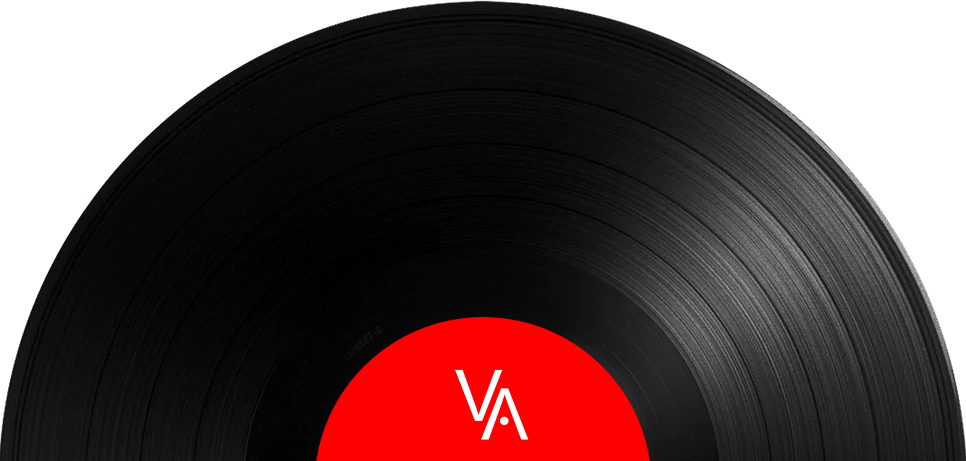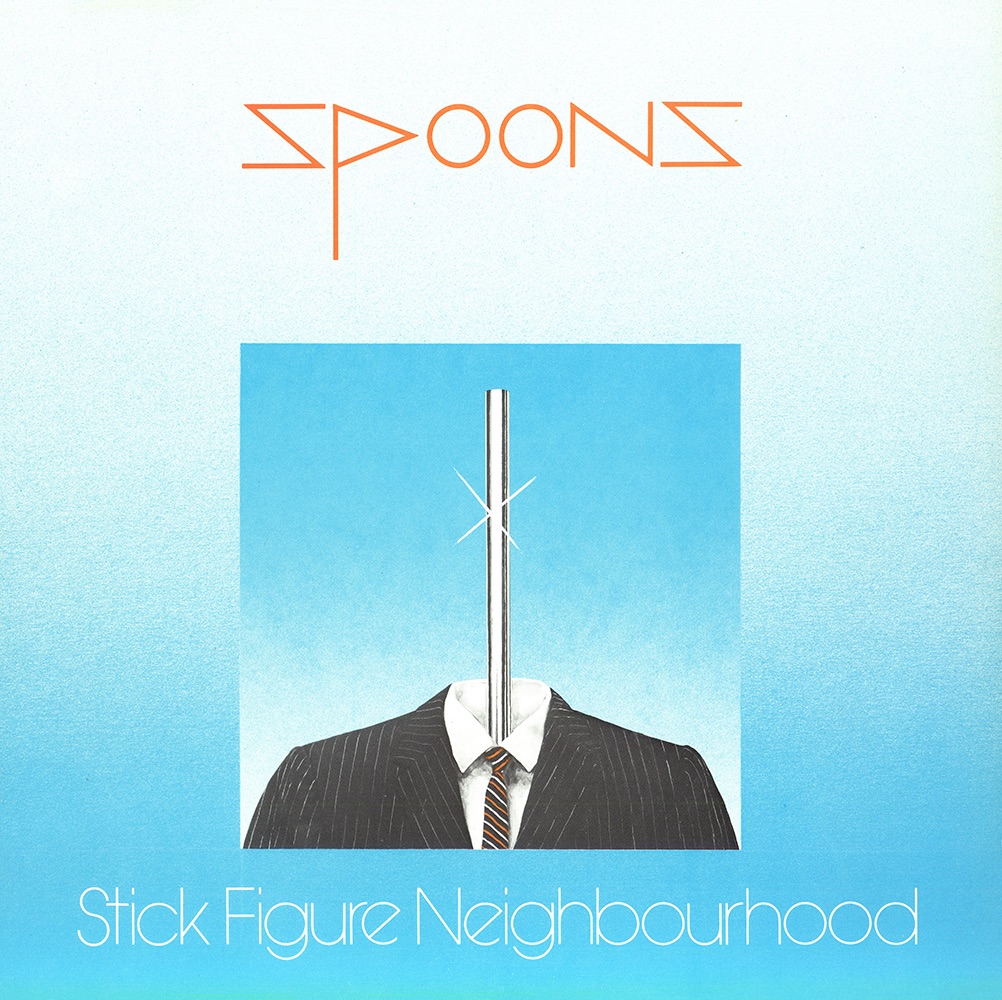
In 1979 I was enrolled at the Ontario College of Art, in Toronto. I lived in Burlington, about an hour away, and commuted daily by GO Train. Another art college student, Brett Wickens, rode the train with me every day. Brett was in a band, and I’d sometimes go watch them rehearse in – I think – a real estate office after-hours, in Aldershot, on the western edge of Burlington. The office was the singer’s dad’s place of work, as I recall. The band was pretty good, and one day, on the train, Brett said to me, “We came up with a name for the band last night.”
I asked him what it was.
He replied, “The Spoons.” He wanted to know what I thought. Truth was, I didn’t think much of it. “It’s OK,” I said. “I guess.” A year or so later Brett left the band and went to England and I left art college. I never saw Brett after that and I forgot all about The Spoons. Then one day, while browsing through the bins at Star Records in Hamilton (one of the best little record shops that ever existed), the clerk played a song that was unlike anything I’d heard up until then. I went up to the front counter and asked him who the band was.
“The Spoons,” he said. “Their first album. The song is called Red Light.”
Seriously? It couldn’t be the same band I had known. But it was, and this record is still a great debut record. It came out in the middle of the so-called “new wave” movement, and it was a fresh sound that was interesting and new. Well, at the time. This record still sounds really good - although now somewhat dated - and I play it every once in a while.
The Spoons went on to have several hits – Nova Heart being their biggest – but this record still ranks up there as one of their best.
Decades later, my daughter – not even a sparkle in my eye when this LP was released – went to see them in concert in Toronto. She said she loved the music. This band, she opined, should have been bigger than they were.
She's right.
The band initially consisted of Gordon Deppe (lead vocals and guitar), Sandy Horne (vocals and bass), Brett Wickens (keyboards, synths), and Peter Shepherd (drums). Deppe, Horne, and Wickens attended Aldershot High School, and Deppe and Horne (the only constant members of the band) dated in high school. The band is said to have got their name as the members were eating alphabet soup at Wickens' home.
Early on they played the songs of their European influences (Genesis was one of them, as I recall) but audiences were less then impressed. In late 1979, Shepherd left the band and was replaced by Derrick Ross, with whom the band released the independent single After the Institution in 1980. Then Wickens left the band to release an electronica album as part of the duo Ceramic Hello, and later became a successful graphic designer who has designed album covers artists such as Peter Gabriel. He was replaced by keyboardist Rob Preuss, who was only 15 when he joined the band.
Stick Figure Neighbourhood was the band's first full-length album and was released in 198. It is notable for being one of the first new wave albums engineered by Daniel Lanois, who owned Hamilton's Grant Avenue Studios. The band soon toured throughout Ontario and Quebec and started to gain a following.
The following year the band released what many consider to be their breakthrough album, Arias & Symphonies, which contained the massive hit single Nova Heart. I still love listening to that song all these years later, especially the extended 12-inch mix that was released later when the song became a dance floor smash.
The year 1983 saw the release of Talkback, an album produced by Nile Rodgers, who had been approached to produce Culture Club, but after seeing them in concert was unimpressed. He was, however, impressed with the opening act - The Spoons - and decided to produce them instead. Talkback included the hit Old Emotions, but was not issued outside of Canada, much to the disappointment of the group.
In 1984 a double 12" containing Tell No Lies and Romantic Traffic - also produced by Rodgers - was released, which was followed in 1986 by Bridges Over Borders, released after The Spoons left Ready Records - which had been unable to secure international releases for their material - and signed with Anthem Records. Both Preuss and Ross would leave the band shortly after and were replaced by Scott MacDonald (keyboards) and Steve Kendry (drums).
The rest of the 1980s saw The Spoon's career peak and then plateau. They would take a break for much of the 1990s, although Deppe and Horne came together for several Spoons reunion gigs during that time and also into the next decade.
In 2007, they released Unexpected Guest at a Cancelled Party, a collection of previously unreleased material recorded between 1982 and 1985 by the Deppe, Horne, Preuss, Ross line-up.
Static in Transmission was recorded and released in 2010, and in 2020 Scott MacDonald returned to the band on keyboards. They were said to be planning a 40th anniversary tour throughout Canada, but due to Coronavirus …
In 1979 I was enrolled at the Ontario College of Art, in Toronto. I lived in Burlington, about an hour away, and commuted daily by GO Train. Another art college student, Brett Wickens, rode the train with me every day. Brett was in a band, and I’d sometimes go watch them rehearse in – I think – a real estate office after-hours, in Aldershot, on the western edge of Burlington. The office was the singer’s dad’s place of work, as I recall. The band was pretty good, and one day, on the train, Brett said to me, “We came up with a name for the band last night.”
I asked him what it was.
He replied, “The Spoons.” He wanted to know what I thought. Truth was, I didn’t think much of it. “It’s OK,” I said. “I guess.” A year or so later Brett left the band and went to England and I left art college. I never saw Brett after that and I forgot all about The Spoons. Then one day, while browsing through the bins at Star Records in Hamilton (one of the best little record shops that ever existed), the clerk played a song that was unlike anything I’d heard up until then. I went up to the front counter and asked him who the band was.
“The Spoons,” he said. “Their first album. The song is called Red Light.”
Seriously? It couldn’t be the same band I had known. But it was, and this record is still a great debut record. It came out in the middle of the so-called “new wave” movement, and it was a fresh sound that was interesting and new. Well, at the time. This record still sounds really good - although now somewhat dated - and I play it every once in a while.
The Spoons went on to have several hits – Nova Heart being their biggest – but this record still ranks up there as one of their best.
Decades later, my daughter – not even a sparkle in my eye when this LP was released – went to see them in concert in Toronto. She said she loved the music. This band, she opined, should have been bigger than they were.
She's right.
The band initially consisted of Gordon Deppe (lead vocals and guitar), Sandy Horne (vocals and bass), Brett Wickens (keyboards, synths), and Peter Shepherd (drums). Deppe, Horne, and Wickens attended Aldershot High School, and Deppe and Horne (the only constant members of the band) dated in high school. The band is said to have got their name as the members were eating alphabet soup at Wickens' home.
Early on they played the songs of their European influences (Genesis was one of them, as I recall) but audiences were less then impressed. In late 1979, Shepherd left the band and was replaced by Derrick Ross, with whom the band released the independent single After the Institution in 1980. Then Wickens left the band to release an electronica album as part of the duo Ceramic Hello, and later became a successful graphic designer who has designed album covers artists such as Peter Gabriel. He was replaced by keyboardist Rob Preuss, who was only 15 when he joined the band.
Stick Figure Neighbourhood was the band's first full-length album and was released in 198. It is notable for being one of the first new wave albums engineered by Daniel Lanois, who owned Hamilton's Grant Avenue Studios. The band soon toured throughout Ontario and Quebec and started to gain a following.
The following year the band released what many consider to be their breakthrough album, Arias & Symphonies, which contained the massive hit single Nova Heart. I still love listening to that song all these years later, especially the extended 12-inch mix that was released later when the song became a dance floor smash.
The year 1983 saw the release of Talkback, an album produced by Nile Rodgers, who had been approached to produce Culture Club, but after seeing them in concert was unimpressed. He was, however, impressed with the opening act - The Spoons - and decided to produce them instead. Talkback included the hit Old Emotions, but was not issued outside of Canada, much to the disappointment of the group.
In 1984 a double 12" containing Tell No Lies and Romantic Traffic - also produced by Rodgers - was released, which was followed in 1986 by Bridges Over Borders, released after The Spoons left Ready Records - which had been unable to secure international releases for their material - and signed with Anthem Records. Both Preuss and Ross would leave the band shortly after and were replaced by Scott MacDonald (keyboards) and Steve Kendry (drums).
The rest of the 1980s saw The Spoon's career peak and then plateau. They would take a break for much of the 1990s, although Deppe and Horne came together for several Spoons reunion gigs during that time and also into the next decade.
In 2007, they released Unexpected Guest at a Cancelled Party, a collection of previously unreleased material recorded between 1982 and 1985 by the Deppe, Horne, Preuss, Ross line-up.
Static in Transmission was recorded and released in 2010, and in 2020 Scott MacDonald returned to the band on keyboards. They were said to be planning a 40th anniversary tour throughout Canada, but due to Coronavirus …


